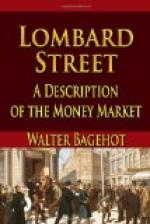’But though plentiful money is necessary to high prices, and though it has a natural tendency to produce these prices, yet it is not of itself sufficient to produce them. In the cases we are dealing with, in order to lower prices there must not only be additional money, but a satisfactory mode of employing that additional money. This is obvious if we remember whence that augmented money is derived. It is derived from the savings of the people, and will only be invested in the manner which the holders for the time being consider suitable to such savings. It will not be used in mere expenditure; it would be contrary to the very nature of it so to use it. A new channel of demand is required to take off the new money, or that new money will not raise prices. It will lie idle in the banks, as we have often seen it. We should still see the frequent, the common phenomenon of dull trade and cheap money existing side by side.
’The demand in this case arose in the most effective of all ways. In 1867 and the first half of 1868 corn was dear, as the following figures show:
Gazette average price of wheat.
s.
d.
December, 1866 60 3
January, 1867 61 4
February 60 10
March 59 9
April 61 6
May 64 8
June 65 8
July 65 0
August 67 8
September 62 8
October 1867 66 6
November 69 5
December 67 4
January, 1868 70 3
February 73 0
March 73 0
April 73 3
May 73 9
June 67 11
July 65 5
From that time it fell, and it was very cheap during the whole of 1869 and 1870. The effect of this cheapness is great in every department of industry. The working classes, having cheaper food, need to spend so much less on that food, and have more to spend on other things. In consequence, there is a gentle augmentation of demand through almost all departments of trade. And this almost always causes a great augmentation in what may be called the instrumental trades—that is, in the trades which deal in machines and instruments used in many branches of commerce, and in the materials for such. Take, for instance, the iron trade—
In the year 1869 we exported 2,568,000 tons
" 1870
" 2,716,000 tons
5,284,000
tons
" 1867
" 1,881,000 tons
" 1868
" 1,944,000 tons
3,826,000
tons
Increase
1,458,000 tons
that is to say, cheap corn operating throughout the world, created a new demand for many kinds of articles; the production of a large number of such articles being aided by iron in some one of its many forms, iron to that extent was exported. And the effect is cumulative. The manufacture of iron being stimulated, all persons concerned in that great manufacture are well off, have more to spend, and by spending it encourage other branches of manufacture, which again propagate the demand; they receive and so encourage industries in a third degree dependent and removed.




